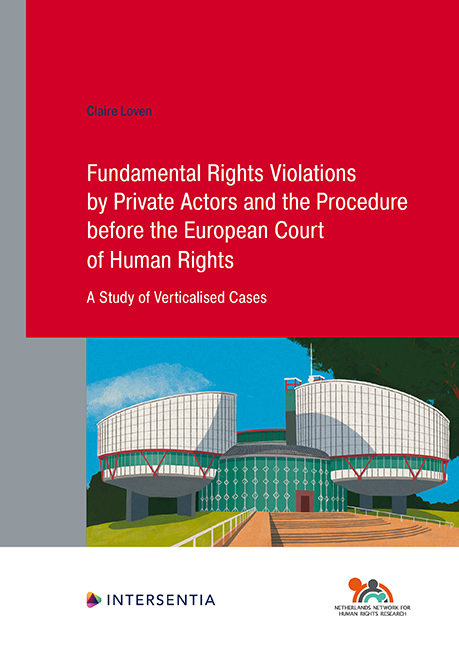 Fundamental Rights Violations by Private Actors and the Procedure before the European Court of Human Rights
Fundamental Rights Violations by Private Actors and the Procedure before the European Court of Human Rights Book contents
- Frontmatter
- Acknowledgments
- Contents
- INTRODUCTION
- PART I INTRODUCTION TO THE CONVENTION SYSTEM
- PART II VERTICALISED CASES UNRAVELLED
- PART III PROBLEMS IN VERTICALISED CASES
- PART IV TOWARDS A NEW APPROACH TO VERTICALISED CASES
- CONCLUSION
- Summary in Dutch
- Bibliography
- Appendix 1 Overview case law sample
- Curriculum Vitae
- Human Rights Research Series
- Frontmatter
- Acknowledgments
- Contents
- INTRODUCTION
- PART I INTRODUCTION TO THE CONVENTION SYSTEM
- PART II VERTICALISED CASES UNRAVELLED
- PART III PROBLEMS IN VERTICALISED CASES
- PART IV TOWARDS A NEW APPROACH TO VERTICALISED CASES
- CONCLUSION
- Summary in Dutch
- Bibliography
- Appendix 1 Overview case law sample
- Curriculum Vitae
- Human Rights Research Series
Summary
In the previous part of this study, it was shown, first, that the Court offers substantive protection of Convention rights in a wide variety of horizontal relations through the concept of horizontal positive obligations. Second, the notion of verticalised cases was unravelled by looking into the origins of verticalised cases; that is, the characteristics of, and the private actors involved in the case at the domestic level, and the Court's approach to them. From this analysis it became clear that an important aspect of verticalised cases is the fact that one of the original parties to the conflict at the domestic level is not involved in the proceedings before the ECtHR. In other words, one of the original parties ‘disappears’ from the conflict when the case comes before the ECtHR. As shown in the previous part, this ‘disappeared party’ can have different characteristics, depending on the nature of the conflict. In verticalised cases related to one's surroundings, for example, it is often the private actor directly responsible for the act that had an impact on the individual's physical or non-physical surroundings who is not involved in the Court's proceedings. Meanwhile, in verticalised cases on a conflict involving the right to reputation and private life and the right to freedom of expression, it is the journalist, the media company or the person who allegedly suffered as a result of the right to freedom of expression being exercised who is not involved in the Court's proceedings. In verticalised family life cases concerning custody and access rights, one of the parents is not involved in the Court's proceedings, whereas in the other type of verticalised family life cases – concerning access to information about one's origins – it is the mother or father (or presumed mother or father), or, if one of the latter complains before the ECtHR, the child, who is not part of the Court's proceedings. Finally, in verticalised employer-employee cases, the employer is the party most likely not to be involved in the Court's proceedings.
In addition to the different characteristics of the disappeared party, there are differences with regard to the Court's approach to verticalised cases. More specifically, it follows from the analysis presented in Chapter 6 that, with the exception of cases related to one's surroundings, the Court generally approaches verticalised cases by examining whether a fair balance was struck between the competing rights and interests of two private actors; that is, the applicant and the disappeared party.
- Type
- Chapter
- Information
- Fundamental Rights Violations by Private Actors and the Procedure before the European Court of Human RightsA Study of Verticalised Cases, pp. 127 - 128Publisher: IntersentiaPrint publication year: 2022


